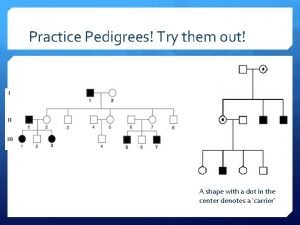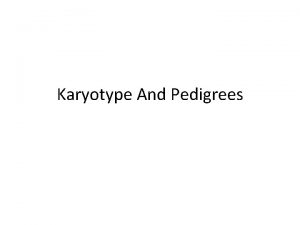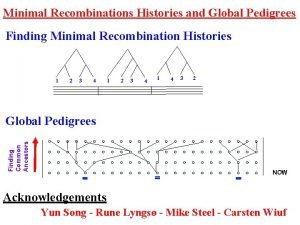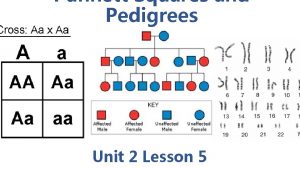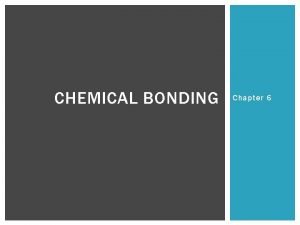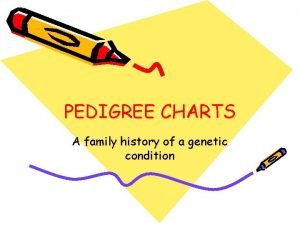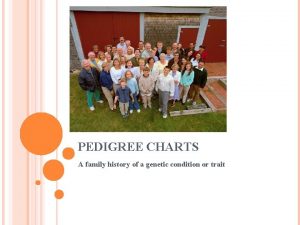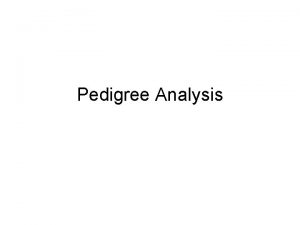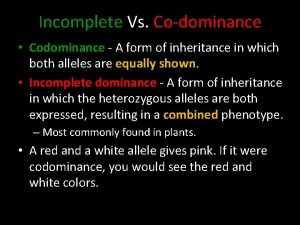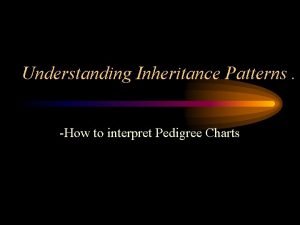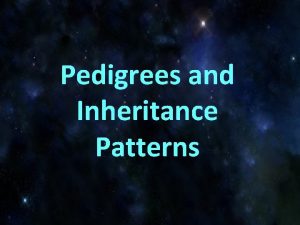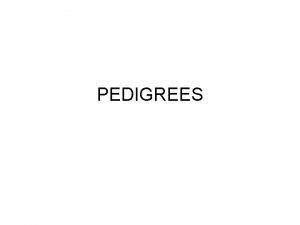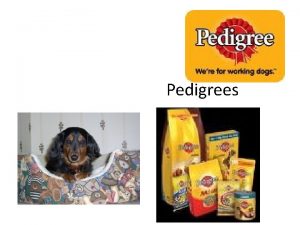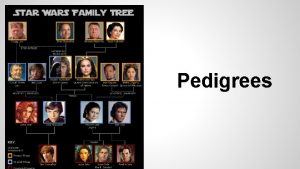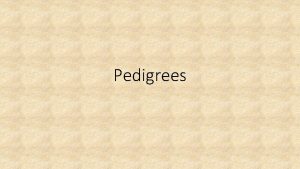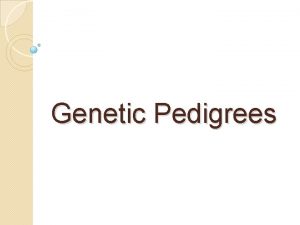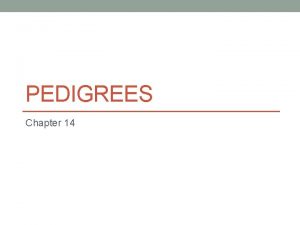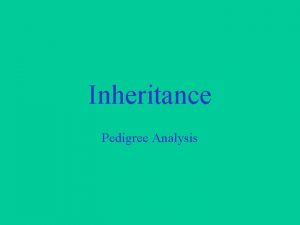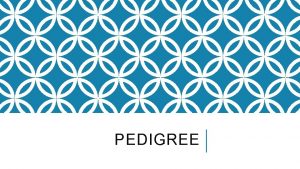PEDIGREES What is a Pedigree A visual representation

















- Slides: 17

PEDIGREES

What is a Pedigree? • A visual representation of how a trait is inherited through generations. • Earliest generations are at the top. • Each row is one generation. • Circle = female, Square = male • Dark shading = affected • SOMETIMES the genotypes are shown below each individual. • SOMETIMES heterozygous individuals are “half shaded. ”

How to read a Pedigree Mating I Indicates the first, second, and third generations. 1 I-1 and I-2’s offspring 2 II-4 mates with II-3 II 1 2 3 4 II-3 and II-4’s offspring III 1 2 3 1) Is individual II-2 male or female? ________ 2) Is individual III-1 male or female? ________ 3) Is individual II-4 affected? _____. How do you know? _________.

Analyzing Pedigrees In humans, the attached earlobe allele is recessive. The free earlobe allele is dominant. F f What are the genotypes of A and B? Clues: 1) Neither A or B have attached earlobes. (How do you know? ) 2) Neither A or B have the homozygous recessive genotype. Could they be heterozygous? 3) A and B have children with the ff genotype. BOTH A & B are heterozygous - Ff Try figuring it out using Punnett Squares!

Autosomal Recessive Traits • Trait is rare in pedigrees • Trait often skips generations (hidden in heterozygous carriers). • Trait affects males and females equally. Example: Cystic Fibrosis

Autosomal Dominant Traits • Trait is common in pedigrees • Trait is found in every generation • There are few autosomal dominant human diseases. Why? (Hint: if the disease is fatal, how likely will the allele be passed on? ) Example: Achondroplasia (causes dwarfism)

X-linked Recessive Traits • Trait is rare in pedigrees. • Trait skips generations. • Affected fathers DO NOT pass the trait to their sons. • Males are more often affected than females. Example: Duchenne Muscular Dystrophy

CHANGES IN DNA

How do Traits Come About? • There were not always blue-eyed people. • Came about 6, 000 years ago. • In fact, EVERY inherited trait had to “arrive” at some point throughout history. • There were not always genetic disorders like cystic fibrosis or sickle cell anemia. New traits and disorders appear due to CHANGES IN DNA.

Mutation • A change in the normal sequence of DNA • This can be caused by external factors • Chemicals, radiation, etc. • This can be caused by internal factors • problems with DNA replication • Mutations are RANDOM. • If in a SOMATIC CELL – change will not be passed on to offspring. • If in a SEX CELL –change WILL be passed on to offspring. There about 4000 known diseases or disorders caused by changes in genetic material.

MUTATIONS ARE NOT ALWAYS HARMFUL! • In fact, they are the basis for EVOLUTION – the reason why organisms are they way they are! • Watch the following video and remember, it is the MUTATIONS that cause new or modified traits which help an individual survive. (ie. Longer necks)

GENETIC DISORDERS 3 WAYS A GENETIC DISORDER CAN ARISE: 1. Change to a single gene 2. Entire Chromosomes duplicated or missing. 3. Multiple changes to one or more genes combined with environmental factors (Causing Cancer)

1. Single Gene Mutations Recall that ONE GENE codes for ONE PROTEIN • If a gene is changed, the protein will be changed. • Each protein in our bodies carry out specific tasks. • Structural or Functional Example: Cystic Fibrosis • Cause: The mutation affects the production of a protein that helps salt (Na. Cl) move into and out of cells. • Physical Effects: • Excessive mucus production on the outside of cells. • Mucus clogs the lungs, affecting respiratory function.

Recall: During Meiosis, chromosomes are equally divided between gametes.

2. Nondisjunction – Causes one less or one more chromosome in each gamete What would happen if any of these gametes were fertilized with a normal gamete?

Some Autosomal Nondisjunction Disorders Down Syndrome – Trisomy 21 • An extra chromosome 21. • Chances of having a baby with down syndrome increases with mother’s age. If over 40 yo, 1/40 chance. Edwards Syndrome – Trisomy 18 • An extra chromosome 18 • Usually fatal – brain, heart, facial, kidney, and stomach malformations.

Sex Chromosome Nondisjunction Disorders Turner Syndrome • Female missing an X chromosome • Short in height, abnormal bone development, low hairline at back of neck Triple X Syndrome • Female with an extra X chromosome • Very mild effects – may be taller, smaller head, speech and learning difficulties Klinefelter’s Syndrome • Male with extra X chromosome • Usually no obvious symptoms • Some have little body hair, enlarged breasts, wide hips, and testicles remain small. XYY Syndrome • Male with extra Y chromosome. • Usually very tall, suffer severe acne during adolescence. • Increased risk for learning/behavioural problems What if a male zygote was missing the X chromosome? • Will not develop properly, resulting in death • There are too many important genes on the X chromosome. It cannot be missing.
 Pedigree representation
Pedigree representation Pedigrees practice ap biology
Pedigrees practice ap biology Pedigree practice
Pedigree practice S
S Pedigrees and karyotypes
Pedigrees and karyotypes Pedigrees edpuzzle
Pedigrees edpuzzle Pedigrees and karyotypes
Pedigrees and karyotypes World pedigrees
World pedigrees The pedigree traces red-green color blindness
The pedigree traces red-green color blindness H h
H h Electronegativity visual representation
Electronegativity visual representation Apa yang dimaksud pemrograman visual
Apa yang dimaksud pemrograman visual Fraternal twins pedigree chart
Fraternal twins pedigree chart Down syndrome pedigree
Down syndrome pedigree Example of x linked recessive
Example of x linked recessive Pedigree analysis
Pedigree analysis Pedigree miscarriage symbol
Pedigree miscarriage symbol Hypertrichosis pedigree chart
Hypertrichosis pedigree chart



